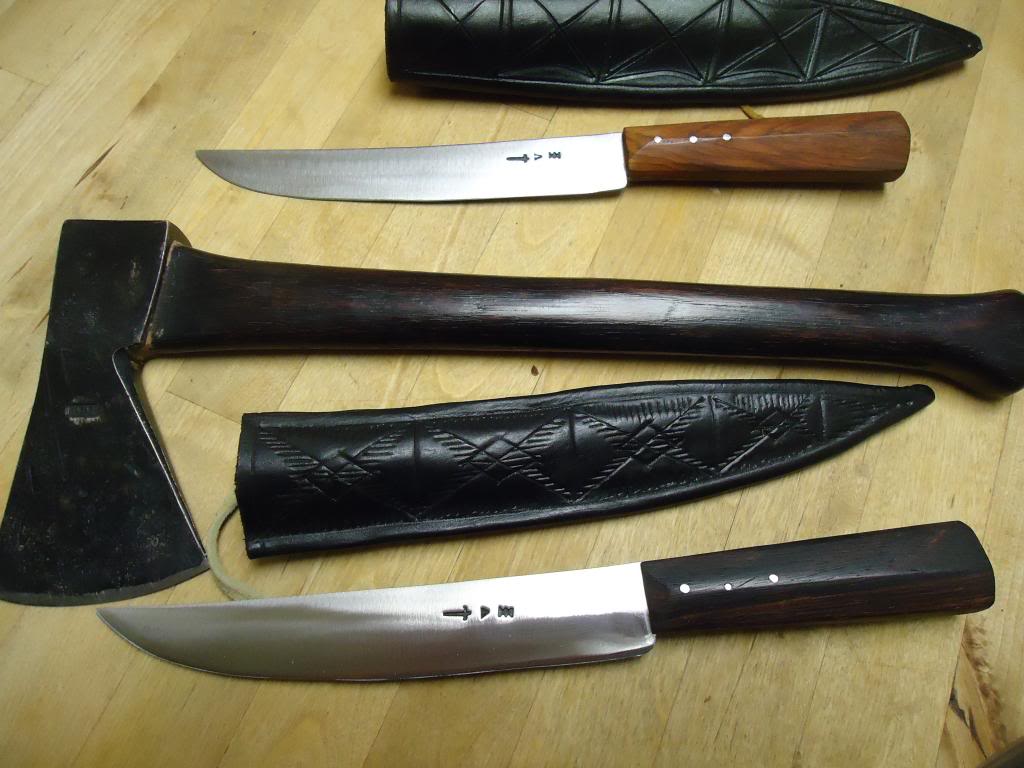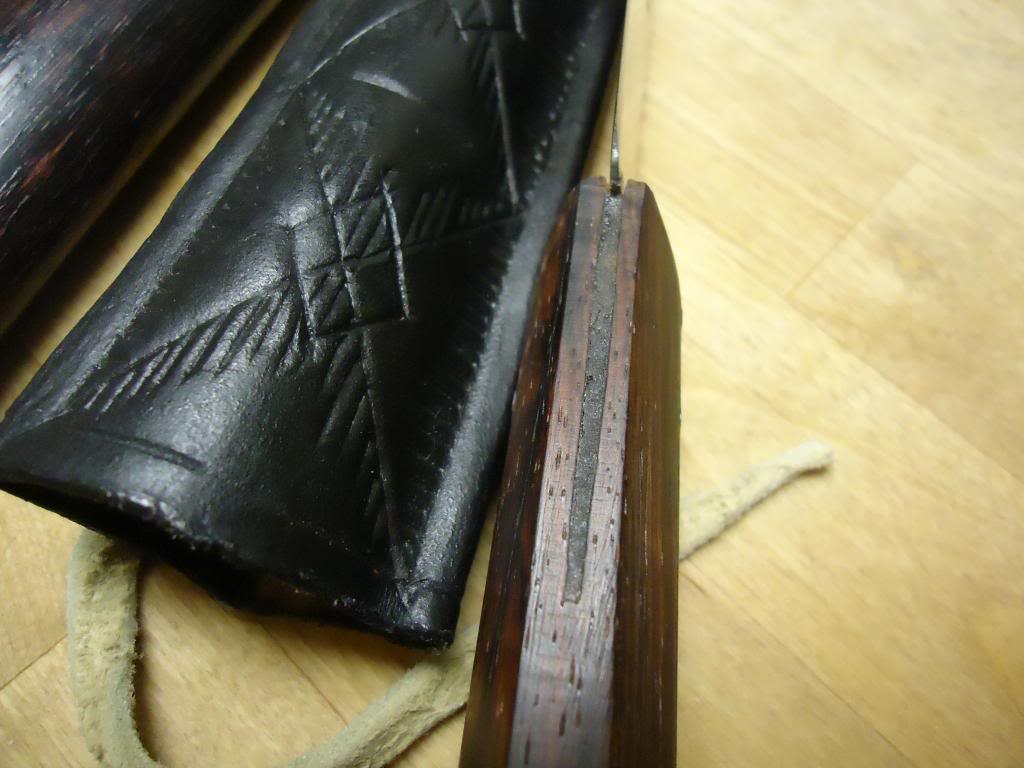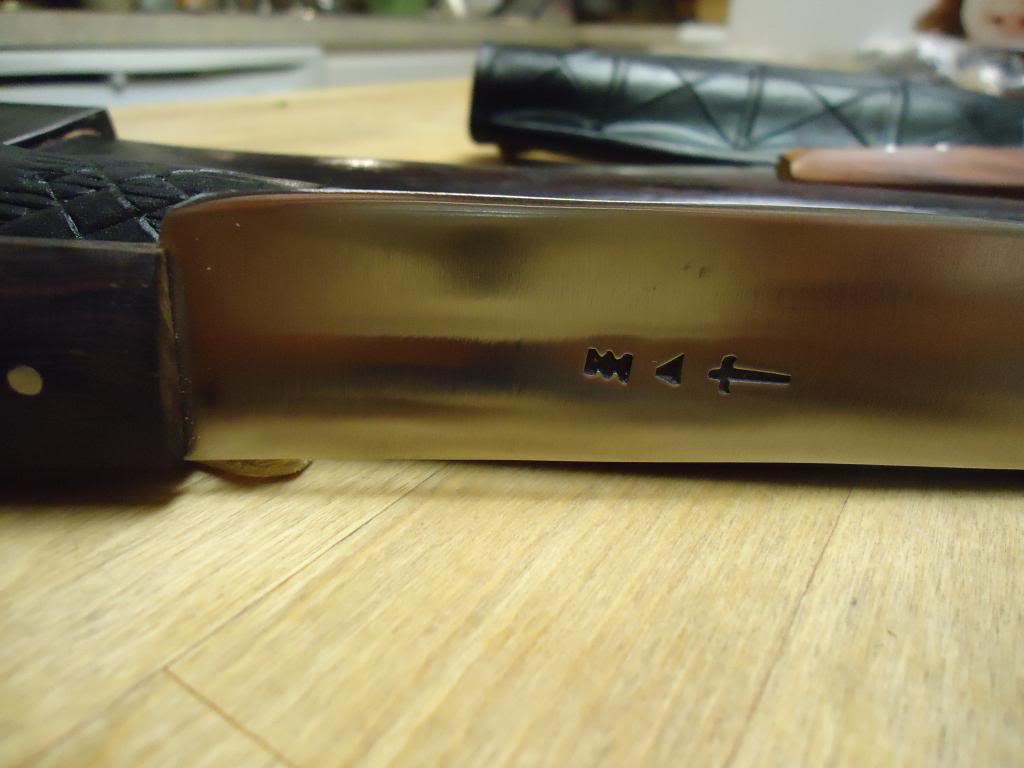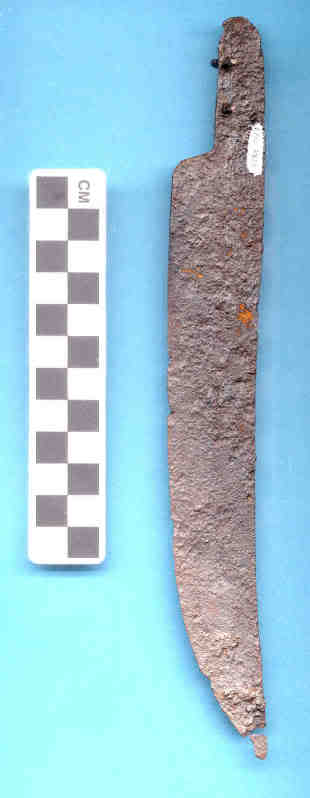
| myArmoury.com is now completely member-supported. Please contribute to our efforts with a donation. Your donations will go towards updating our site, modernizing it, and keeping it viable long-term.
Last 10 Donors: Anonymous, Daniel Sullivan, Chad Arnow, Jonathan Dean, M. Oroszlany, Sam Arwas, Barry C. Hutchins, Dan Kary, Oskar Gessler, Dave Tonge (View All Donors) |
| Author |
Message |
|
Jim B Williams
Location: Virginia Joined: 29 May 2013
Posts: 25
|
 Posted: Tue 19 Aug, 2014 7:00 pm Post subject: 18th Century English Scalping Knives Posted: Tue 19 Aug, 2014 7:00 pm Post subject: 18th Century English Scalping Knives |
 |
|
As part of my interest in 1750's through 1780's material history and living history, I've gone through different iterations of the "rifleman's knife"/"scalping knife" and come to the conclusion that in my place of interest, the common Sheffield-made butcher knife was by far the most common knife on the frontier. imported by the thousands from England (the French had their own versions which is a separate discussion), they were traded to Indians and sold in stores and trading posts all over the colonies. These are the knives that Indians, market hunters, militia, and riflemen carried. You can see the same blade profile in mid-18th century paintings and marketed as "fish knives." They were traded in North American as "butchers" and eventually marketed to Indians as "Scalping knives." HA!
Below are two repros by Ken Hamilton, who specializes in 18th century French stuff but makes the best English scalpers anywhere. No two are alike just as they were in the 18th century. The touch marks are original, which were likely Sheffield-made knock-offs of London commercial makers (based on the fact that London cutlers mainly dealt in small production fine cutlery rather than mass-produced, cheaper stuff for the trade). The stone-ground finish is correct for the period, the exotic wood for the handles (woods imported from Africa and other places) in this case is rose wood and cocobolo on the other. The gap created by the thin tang is filled with "cutler's cement" which is pitch mixed with brick dust as it was in the period. This also creates supports the pins in holding everything together.
The hatchet in the picture is made by Kyle Willyard of Old Dominion forge and is based on one found in George Neumann's "Swords and Blades of the American Revolution."



Original which still has the diamond-shaped handle:

Another dug original blade, one of the myriad of these dug up all over 18th century Indian and military sites:

One more, for good measure:

|
|
  |
 |
Shahril Dzulkifli

|
 Posted: Fri 22 Aug, 2014 4:06 am Post subject: 18th Century English Scalping Knives Posted: Fri 22 Aug, 2014 4:06 am Post subject: 18th Century English Scalping Knives |
 |
|

Although scalping in name only, the knives were not really used in scalping, instead they were used to skin animals. It was not the English settlers´ custom of scalping their enemies´ heads when they first arrived on North American shores.
“You have power over your mind - not outside events. Realize this, and you will find strength”
- Marcus Aurelius
|
|
  |
 |
|
Perry L. Goss
|
 Posted: Fri 22 Aug, 2014 5:57 am Post subject: English 18c blade Posted: Fri 22 Aug, 2014 5:57 am Post subject: English 18c blade |
 |
|
Nice.
Yeah, sorry to say but one can attend many re-enachtments and the standard is a blade with deer antler. A lot vendors and blogs present them. Sure they existed, but...the vast majority of blades were as you say mass produced. Then at the other end were the specially mounted and crafted top end items.
Thank you for the post.
|
|
  |
 |
|
Jim B Williams
Location: Virginia Joined: 29 May 2013
Posts: 25
|
 Posted: Fri 22 Aug, 2014 12:33 pm Post subject: Re: 18th Century English Scalping Knives Posted: Fri 22 Aug, 2014 12:33 pm Post subject: Re: 18th Century English Scalping Knives |
 |
|
| Shahril Dzulkifli wrote: |
Although scalping in name only, the knives were not really used in scalping, instead they were used to skin animals. It was not the English settlers´ custom of scalping their enemies´ heads when they first arrived on North American shores. |
Shahril,, from my post: "You can see the same blade profile in mid-18th century paintings and marketed as "fish knives." They were traded in North American as "butchers" and eventually marketed to Indians as "Scalping knives." HA! "
So yes, "scalping knife" is a marketing term in the 18th century trade lists, but they were without a doubt used at times for more violent purposes than mere meat processing and fish gutting. Plenty of references of back country/frontier warfare using "scalpers" for removing the scalp from person's head.
That said, the primary purpose of these blades as used by European Americans, was for butchering meat, gutting fish, etc.
|
|
  |
 |
|
Jim B Williams
Location: Virginia Joined: 29 May 2013
Posts: 25
|
 Posted: Fri 22 Aug, 2014 12:45 pm Post subject: Re: English 18c blade Posted: Fri 22 Aug, 2014 12:45 pm Post subject: Re: English 18c blade |
 |
|
| Perry L. Goss wrote: | Nice.
Yeah, sorry to say but one can attend many re-enachtments and the standard is a blade with deer antler. A lot vendors and blogs present them. Sure they existed, but...the vast majority of blades were as you say mass produced. Then at the other end were the specially mounted and crafted top end items.
Thank you for the post. |
Perry, ain't that the truth. A lot of these reenactorisms make their way into the popular mindset, which as a general rule, is a detriment to historical education. I think the big antler-handled, homespun knives are an extension of the myth of frontier independence. We like to think of the American frontier as a place where we (Indians and Euros alike) were completely self-reliant and made everything we had from raw materials. With limited exceptions, Indians and Euros very much reliant on the World economy which was sophisticated even by today's standards.
Since we focus on martial history here, scalping knives are a good example, as is gun powder, type "G" trade guns and other Indian trade firearms, steel tomahawks, etc. Even the American Longrifle was often (though not exclusively) crafted using imported parts.
|
|
  |
 |
Sean Flynt

|
|
   |
 |
J. Nicolaysen

|
 Posted: Sat 23 Aug, 2014 12:01 pm Post subject: Posted: Sat 23 Aug, 2014 12:01 pm Post subject: |
 |
|
These are nice and pretty interesting. Here in WY one of the large re-enactor eras is Mountain Men, and the Green River style trapping knife seems to be a popular one among re-enactors although the Russell company may not have sent them out here so early. http://www.mman.us/mythgreenriver.htm
I have used a modern production knife with the deep belly for skinning elk and it works very well. http://www.crazycrow.com/green-river-knives
All of the fur trade in WY is a good 50 to 75 years later than when these knives were used, but the look of some of them is similar, and I think the Russell company and certain others would have been very influenced by these earlier "scalping" knives.
I don't do any re-enactment myself, but one of these days I would like to see the Green River Rendezvous which is a pretty big gathering. http://www.meetmeonthegreen.com/ The local blackpowder group is often in period dress. I don't know what they carry for knives.
|
|
  |
 |
|
Hadrian Coffin
Industry Professional
Location: Oxford, England Joined: 03 Apr 2008
Posts: 404
|
 Posted: Sat 23 Aug, 2014 8:42 pm Post subject: Posted: Sat 23 Aug, 2014 8:42 pm Post subject: |
 |
|
Those look wonderful, and I'd love to buy one… but I can't seem to find his website googling.
Any help?
Cheers,
Hadrian
Historia magistra vitae est
|
|
   |
 |
|
Perry L. Goss
|
 Posted: Sun 24 Aug, 2014 5:48 am Post subject: plain & simple Posted: Sun 24 Aug, 2014 5:48 am Post subject: plain & simple |
 |
|
| Sean Flynt wrote: | | Lovely stuff! I'm a big fan of early American knives--this period and up through the early butcher/Bowies. The simpler the better! |
Sean, you asked for it 
One of my favorites is Sam Houston's blade from that era. 'Bout half way down this page. A lot of these are 1830 on, but...
Yesterday in an antique shop on I-70 in MO I found an early blade in fair shape stamped with maker's mark and 1834 on it! Six steel pins. $8.75!
http://johnwayne-thealamo.com/forum/viewtopic.php?f=9&p=43878
Then these gems:
http://www.timlively.com/oldbowies.htm
And just almost any of the earlier ones here:
http://www.relentlessknives.com/BowieHistory.html
Scottish: Ballentine, Black, Cameron, Chisholm, Cunningham, Crawford, Grant, Jaffray, MacFarlane, MacGillivray, MacKay-Reay/Strathnaver, Munro, Robertson, Sinclair, Wallace
Irish/Welsh: Bodkin, Mendenhall, Hackworth
Swiss: Goss von Rothenfluh, Naff von Zurich und Solland von Appenzel
|
|
  |
 |
|
Perry L. Goss
|
 Posted: Sun 24 Aug, 2014 6:08 am Post subject: Re: English 18c blade Posted: Sun 24 Aug, 2014 6:08 am Post subject: Re: English 18c blade |
 |
|
| Jim B Williams wrote: | | Perry L. Goss wrote: | Nice.
Yeah, sorry to say but one can attend many re-enachtments and the standard is a blade with deer antler. A lot vendors and blogs present them. Sure they existed, but...the vast majority of blades were as you say mass produced. Then at the other end were the specially mounted and crafted top end items.
Thank you for the post. |
Perry, ain't that the truth. A lot of these reenactorisms make their way into the popular mindset, which as a general rule, is a detriment to historical education. I think the big antler-handled, homespun knives are an extension of the myth of frontier independence. We like to think of the American frontier as a place where we (Indians and Euros alike) were completely self-reliant and made everything we had from raw materials. With limited exceptions, Indians and Euros very much reliant on the World economy which was sophisticated even by today's standards.
Since we focus on martial history here, scalping knives are a good example, as is gun powder, type "G" trade guns and other Indian trade firearms, steel tomahawks, etc. Even the American Longrifle was often (though not exclusively) crafted using imported parts. |
Jim:
For sure, totally agree with your assessment. Repurposed was the name of the game. For instance, English bowie knives were nickle plated about 5 years before the American ones were. Technology just was not here. These posts cover a later period than we normally cover here...but still cool stuff.
I recently found a cutoe blade, cut down - that had been turned into a corn knife here in MO. Yikes! Craig of A & A is turning it into a Scottish Dirk. Man I can't wait for that little gem to arrive! Will most assuredly post pics when she gets here 
Hope this works...nope did not. I will pm you an original James Black. Later period I know, but totally cool. Maybe you can post? I am not good at this. Friend has it, one of the guys that hangs out with Jake Powning and Owen Bush. They are "restoring" two. 8 were made as presentations for a Masonic shindig. Only three are known to survive.
Thank you
|
|
  |
 |
|
Jim B Williams
Location: Virginia Joined: 29 May 2013
Posts: 25
|
 Posted: Sun 24 Aug, 2014 6:30 pm Post subject: Posted: Sun 24 Aug, 2014 6:30 pm Post subject: |
 |
|
| Hadrian Coffin wrote: | Those look wonderful, and I'd love to buy one… but I can't seem to find his website googling.
Any help?
Cheers,
Hadrian |
Hadrian,
I sent you a PM.
James
|
|
  |
 |
|
Jim B Williams
Location: Virginia Joined: 29 May 2013
Posts: 25
|
 Posted: Sun 24 Aug, 2014 6:33 pm Post subject: Re: English 18c blade Posted: Sun 24 Aug, 2014 6:33 pm Post subject: Re: English 18c blade |
 |
|
| Perry L. Goss wrote: |
I recently found a cutoe blade, cut down - that had been turned into a corn knife here in MO. Yikes! Craig of A & A is turning it into a Scottish Dirk. Man I can't wait for that little gem to arrive! Will most assuredly post pics when she gets here 
|
Sweet! Will definitely want to see picks of that. I've been eyeing A&A's Morgan Bible dagger for some time. Love all of their custom work.
|
|
  |
 |
|
Hadrian Coffin
Industry Professional
Location: Oxford, England Joined: 03 Apr 2008
Posts: 404
|
 Posted: Sun 24 Aug, 2014 7:33 pm Post subject: Posted: Sun 24 Aug, 2014 7:33 pm Post subject: |
 |
|
Mr. Williams, I wanted to thank you, but also ask if you could possibly re-send it. It doesn't appear to be in my inbox, unfortunately.
Best,
Hadrian
Historia magistra vitae est
|
|
   |
 |
|
Eric W. Norenberg
|
 Posted: Mon 25 Aug, 2014 12:07 am Post subject: Posted: Mon 25 Aug, 2014 12:07 am Post subject: |
 |
|
Wow, Jim, those are great! Thanks for sharing those.
I'll echo the others, I too love these early American knives. My family has become obsessed with the exploration and "taming" of the American West recently (spent a week at various Lewis and Clark sites here in the Pacific NW) and these are right up our alley. The finish on the blades and the geometry of the handles are lovely!
You mentioned in your opening post that the "touch marks are original" - meaning that Mr. Hamilton has replicated 18th C. marks, or that they are his own marks? Just curious.
Cheers,
Eric
|
|
  |
 |
Sean Flynt

|
|
   |
 |
|
Jim B Williams
Location: Virginia Joined: 29 May 2013
Posts: 25
|
 Posted: Mon 25 Aug, 2014 11:16 am Post subject: Posted: Mon 25 Aug, 2014 11:16 am Post subject: |
 |
|
| Eric W. Norenberg wrote: |
You mentioned in your opening post that the "touch marks are original" - meaning that Mr. Hamilton has replicated 18th C. marks, or that they are his own marks? Just curious.
|
Eric,
Ken reproduces original marks found on excavated items and can be found in the Sheffield registry of maker's marks.
Jim
|
|
  |
 |
|
|
You cannot post new topics in this forum
You cannot reply to topics in this forum
You cannot edit your posts in this forum
You cannot delete your posts in this forum
You cannot vote in polls in this forum
You cannot attach files in this forum
You can download files in this forum
|
All contents © Copyright 2003-2024 myArmoury.com — All rights reserved
Discussion forums powered by phpBB © The phpBB Group
Switch to the Basic Low-bandwidth Version of the forum
|

